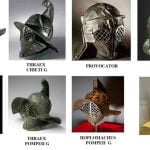There is a widespread – mistaken – belief that the ancient Romans always wore sandals and dressed in tunics to withstand the warm climate in the Mediterranean. It must be remembered, however, that Roman legions conquered also Gaul, Germania or Britain. There, temperatures, like today, were lower and in the winter heavy snow was falling. The Romans, wanting to survive in such conditions, had to protect the body against hypothermia.
The first of the clothes that allowed Romans to survive the cold climate in northern Europe was the mantle. Two types of Roman cloaks were distinguished: paenula and sagum. Especially the second type was unusually large and heavy (and therefore warm); the paenula, in turn, was distinguished by a hood. As evidenced by the Roman stella found on the Rhine, the Romans sometimes also used subpaenulae, a protective layer put under the coat. Interestingly, these coats were very resistant to water because they retained lanolin – animal wax.
Romans also naturally had to protect their usually exposed feet and legs from freezing temperatures. Socks (udones) were used for this purpose. We know this, among others, from the letters found in the Roman camp in Britain – Vindolanda; soldiers received such gifts from families. The socks were made in two ways: (1) by cutting fabric pieces and stitching them from the fabric or (2) by crocheting. Artifacts of each type were found in Gaul and even in Egypt.
In order to protect the calves, rectangular pieces were used, which were wrapped around the legs and tied to hanging chains of material. This dress is probably of Germanic origin and was used in Britain. The logic of the operation of this dress is similar to the wrappers used in the nineteenth and twentieth century. Antique wrappers were termed fascia.
Another way to protect the legs from the cold were pants, which in the mind of the Romans were a determinant of barbarity. They were worn by the Celtic and Germanic tribes, and therefore enjoyed little recognition. It is certain, however, that the Romans appreciated their usefulness and certainly they were worn. The earliest evidence for this comes from the period of the Dacian wars (the beginning of the 2nd century CE).
Another way – one of the most favorite – to keep body warm was to wear several tunics at once. The Emperor Augustus, for example, wore no less than 4 tunics and a toga. It is also possible that Roman legionaries bought local long tunics with sleeves.
To protect the neck, a shawl (focale) was used, which was largely similar to our contemporaries. To protect the head, hats were worn. We know that the Romans wore caps with roundabouts on very sunny and hot days to protect themselves from the intense sunrays. Researchers believe that the Romans wore similar hats in a cold climate to protect their heads from being cold. At present, it is believed that helmets could be covered with a cladding form, or, as Vegetius says, soldiers wore heavy leather hats. It is also possible that the hats were waterproof. Certainly, the protection of the head was not expensive and an ordinary legionary could afford it.
In summary, the ancient Romans were able to adapt to cooler weather conditions and often used other / local solutions for that.







